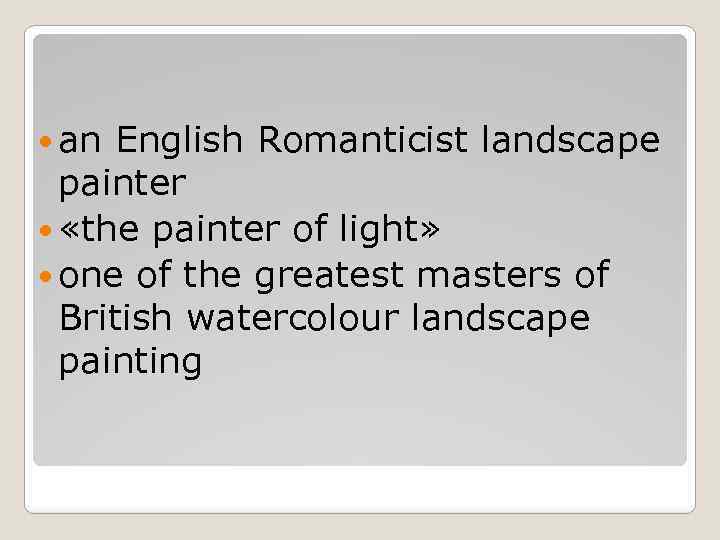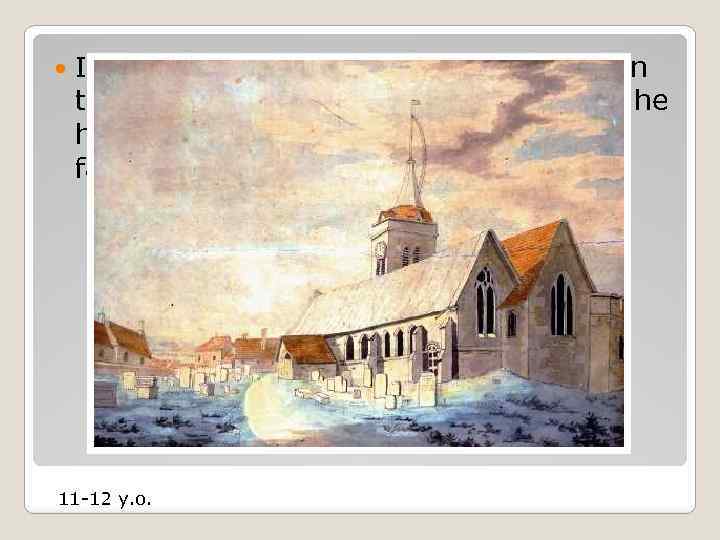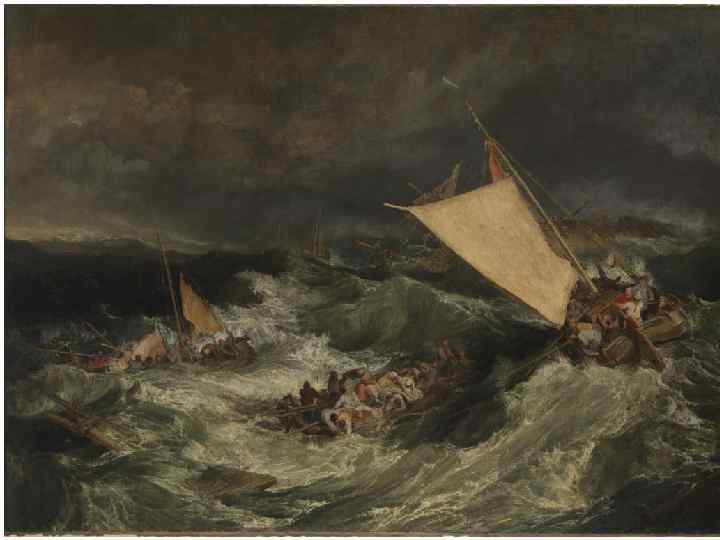 J. M. W. Turner Joseph Mallord William Ira Glazyrina 11 a Self-portrait, oil on canvas, circa 1799 c. late April – early May 1775 19 December 1851
J. M. W. Turner Joseph Mallord William Ira Glazyrina 11 a Self-portrait, oil on canvas, circa 1799 c. late April – early May 1775 19 December 1851
 an English Romanticist landscape painter «the painter of light» one of the greatest masters of British watercolour landscape painting
an English Romanticist landscape painter «the painter of light» one of the greatest masters of British watercolour landscape painting
 Turner was born in Maiden Lane, Covent Garden, London, England. His father, William Gay Turner was a barber and wig maker. His mother, Mary Marshall, became increasingly mentally unstable. She died in 1804, after having been committed to a mental asylum in 1799 c. 1850's
Turner was born in Maiden Lane, Covent Garden, London, England. His father, William Gay Turner was a barber and wig maker. His mother, Mary Marshall, became increasingly mentally unstable. She died in 1804, after having been committed to a mental asylum in 1799 c. 1850's
 In 1786 he went to school in Margate on the north-east Kent coast. By this time he had created many drawings, which his father exhibited in his shop window. 11 -12 y. o.
In 1786 he went to school in Margate on the north-east Kent coast. By this time he had created many drawings, which his father exhibited in his shop window. 11 -12 y. o.
 Henry Singleton's The Royal Academicians assembled in their council chamber to adjudge the Medals to the successful students in Painting, Sculpture, Architecture and Drawing, which hangs in the Royal Academy. Ca. He entered the Royal Academy of Art 1793. schools in 1789, when he was only 14 years old, and was accepted into the academy a year later. View in the Avon Gorge 1791
Henry Singleton's The Royal Academicians assembled in their council chamber to adjudge the Medals to the successful students in Painting, Sculpture, Architecture and Drawing, which hangs in the Royal Academy. Ca. He entered the Royal Academy of Art 1793. schools in 1789, when he was only 14 years old, and was accepted into the academy a year later. View in the Avon Gorge 1791
 A View of the Archbishop's Palace, Lambeth A watercolour of Turner's was accepted for the Summer Exhibition of 1790 after only one year's study.
A View of the Archbishop's Palace, Lambeth A watercolour of Turner's was accepted for the Summer Exhibition of 1790 after only one year's study.
 He exhibited his first oil painting in 1796, Fishermen at Sea, and thereafter exhibited at the academy nearly every year for the rest of his life.
He exhibited his first oil painting in 1796, Fishermen at Sea, and thereafter exhibited at the academy nearly every year for the rest of his life.
 Paris: The Pont Neuf and the Ile de la Cité c. 1833 Paris: Hôtel de Ville c. 1833 Turner travelled widely in Europe, starting with France and Switzerland in 1802 and studying in the Louvre in Paris in the same year. He made many visits to Venice. The Rigi - painted by Turner more than 30 times - was an iconic mountain for 19 th-century travellers. Queen Victoria herself stayed overnight on the summit. This is Turner's famous watercolour The Blue Rigi currently on show at the Tate Britain exhibition of his late work
Paris: The Pont Neuf and the Ile de la Cité c. 1833 Paris: Hôtel de Ville c. 1833 Turner travelled widely in Europe, starting with France and Switzerland in 1802 and studying in the Louvre in Paris in the same year. He made many visits to Venice. The Rigi - painted by Turner more than 30 times - was an iconic mountain for 19 th-century travellers. Queen Victoria herself stayed overnight on the summit. This is Turner's famous watercolour The Blue Rigi currently on show at the Tate Britain exhibition of his late work
 Venice, San Giorgio Maggiore from the Entrance to the Grand 'Venice, Moonrise', 1840 Looking East from the Guidecca, Sunrise, 1819 Venice, for Rogers's 'Italy' c. 1826 -7 The Piazzetta, Venice. About 1835 Venice, from the Porch of Madonna della Salute, ca. 1835
Venice, San Giorgio Maggiore from the Entrance to the Grand 'Venice, Moonrise', 1840 Looking East from the Guidecca, Sunrise, 1819 Venice, for Rogers's 'Italy' c. 1826 -7 The Piazzetta, Venice. About 1835 Venice, from the Porch of Madonna della Salute, ca. 1835
 As he grew older, Turner became more eccentric. He had few close friends except for his father, who lived with him for thirty years, eventually working as his studio assistant. His father's death in 1829 had a profound effect on him, and thereafter he was subject to bouts of depression.
As he grew older, Turner became more eccentric. He had few close friends except for his father, who lived with him for thirty years, eventually working as his studio assistant. His father's death in 1829 had a profound effect on him, and thereafter he was subject to bouts of depression.
 He never married but had a relationship with an older widow, Sarah Danby. He is believed to have been the father of her two daughters born in 1801 and 1811
He never married but had a relationship with an older widow, Sarah Danby. He is believed to have been the father of her two daughters born in 1801 and 1811
 He died in the house of his mistress Sophia Caroline Booth in Cheyne Walk, Chelsea on 19 December 1851. He is said to have uttered the last words "The sun is God" before expiring. George Jones Turner's Body lying in State, 29 December 1851
He died in the house of his mistress Sophia Caroline Booth in Cheyne Walk, Chelsea on 19 December 1851. He is said to have uttered the last words "The sun is God" before expiring. George Jones Turner's Body lying in State, 29 December 1851
 In his early paintings Turner attempted to master other styles he admired, such as the realistic, orderly pictorial techniques of Willem van der Velde and Claude Lorrain, but by 1805 his oil sketches and paintings such as The Shipwreck demonstrated his own original approach to landscapes and seascapes.
In his early paintings Turner attempted to master other styles he admired, such as the realistic, orderly pictorial techniques of Willem van der Velde and Claude Lorrain, but by 1805 his oil sketches and paintings such as The Shipwreck demonstrated his own original approach to landscapes and seascapes.
 Suitable vehicles for Turner's imagination were found in shipwrecks, fires (such as the burning of Parliament in 1834, an event which Turner rushed to witness first -hand, and which he transcribed in a series of watercolour sketches), natural catastrophes, and natural phenomena such as sunlight, storm, rain, and fog.
Suitable vehicles for Turner's imagination were found in shipwrecks, fires (such as the burning of Parliament in 1834, an event which Turner rushed to witness first -hand, and which he transcribed in a series of watercolour sketches), natural catastrophes, and natural phenomena such as sunlight, storm, rain, and fog.
 By his late 30 s, his work became increasingly atmospheric and luminous. In paintings such as Snowstorm: Hannibal and his Army Crossing the Alps (1812), he started to focus his efforts on portraying the power of nature and man's insignificance in the face of it.
By his late 30 s, his work became increasingly atmospheric and luminous. In paintings such as Snowstorm: Hannibal and his Army Crossing the Alps (1812), he started to focus his efforts on portraying the power of nature and man's insignificance in the face of it.
 In addition to painting, Turner was interested in poetry, especially Walter Scott, Lord Byron, Thomas Moore and John Milton, and he wrote his own poetry as well, including an unfinished and unpublished work, Fallacies of Hope, in 1812. Much later, when Turner exhibited Slave Ship (Slavers Throwing Overboard the Dead and Dying, Typhoon Coming On) (1840) at the Royal Academy, he included excerpts of his poetry alongside the painting.
In addition to painting, Turner was interested in poetry, especially Walter Scott, Lord Byron, Thomas Moore and John Milton, and he wrote his own poetry as well, including an unfinished and unpublished work, Fallacies of Hope, in 1812. Much later, when Turner exhibited Slave Ship (Slavers Throwing Overboard the Dead and Dying, Typhoon Coming On) (1840) at the Royal Academy, he included excerpts of his poetry alongside the painting.
 Rain, Steam, and Speed - the Great Western Railway(1844) The Fighting Temeraire tugged to her last berth to be broken up (1839) Turner continued to travel in his later years, visiting Italy, Switzerland, Germany, France, Denmark and Czechoslovakia. He sketched tirelessly, and his bequest included approximately 19, 000 sketches from these travels. His paintings became more fluid and atmospheric with minimal details.
Rain, Steam, and Speed - the Great Western Railway(1844) The Fighting Temeraire tugged to her last berth to be broken up (1839) Turner continued to travel in his later years, visiting Italy, Switzerland, Germany, France, Denmark and Czechoslovakia. He sketched tirelessly, and his bequest included approximately 19, 000 sketches from these travels. His paintings became more fluid and atmospheric with minimal details.
 «My job is to draw what I see, not what I know»
«My job is to draw what I see, not what I know»


